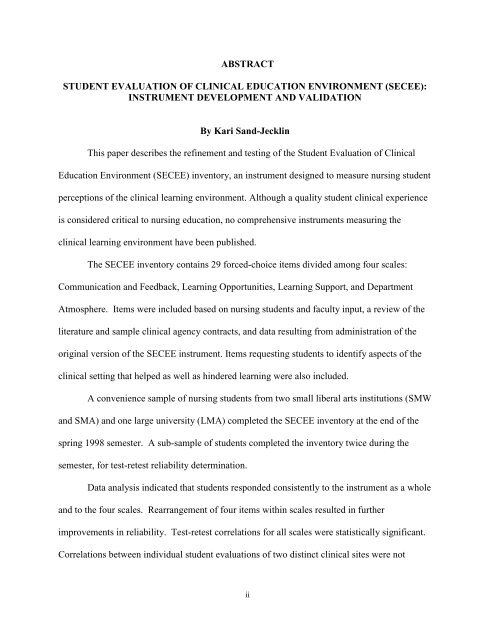STUDENT EVALUATION OF CLINICAL EDUCATION ENVIRONMENT
STUDENT EVALUATION OF CLINICAL EDUCATION ENVIRONMENT
STUDENT EVALUATION OF CLINICAL EDUCATION ENVIRONMENT
You also want an ePaper? Increase the reach of your titles
YUMPU automatically turns print PDFs into web optimized ePapers that Google loves.
ABSTRACT<br />
<strong>STUDENT</strong> <strong>EVALUATION</strong> <strong>OF</strong> <strong>CLINICAL</strong> <strong>EDUCATION</strong> <strong>ENVIRONMENT</strong> (SECEE):<br />
INSTRUMENT DEVELOPMENT AND VALIDATION<br />
By Kari Sand-Jecklin<br />
This paper describes the refinement and testing of the Student Evaluation of Clinical<br />
Education Environment (SECEE) inventory, an instrument designed to measure nursing student<br />
perceptions of the clinical learning environment. Although a quality student clinical experience<br />
is considered critical to nursing education, no comprehensive instruments measuring the<br />
clinical learning environment have been published.<br />
The SECEE inventory contains 29 forced-choice items divided among four scales:<br />
Communication and Feedback, Learning Opportunities, Learning Support, and Department<br />
Atmosphere. Items were included based on nursing students and faculty input, a review of the<br />
literature and sample clinical agency contracts, and data resulting from administration of the<br />
original version of the SECEE instrument. Items requesting students to identify aspects of the<br />
clinical setting that helped as well as hindered learning were also included.<br />
A convenience sample of nursing students from two small liberal arts institutions (SMW<br />
and SMA) and one large university (LMA) completed the SECEE inventory at the end of the<br />
spring 1998 semester. A sub-sample of students completed the inventory twice during the<br />
semester, for test-retest reliability determination.<br />
Data analysis indicated that students responded consistently to the instrument as a whole<br />
and to the four scales. Rearrangement of four items within scales resulted in further<br />
improvements in reliability. Test-retest correlations for all scales were statistically significant.<br />
Correlations between individual student evaluations of two distinct clinical sites were not<br />
ii












